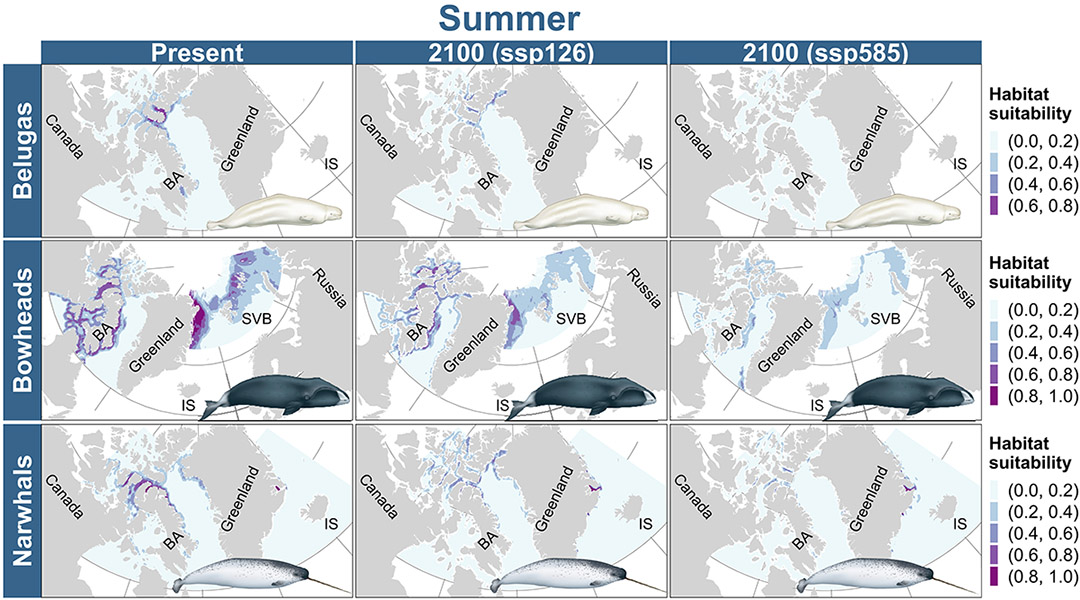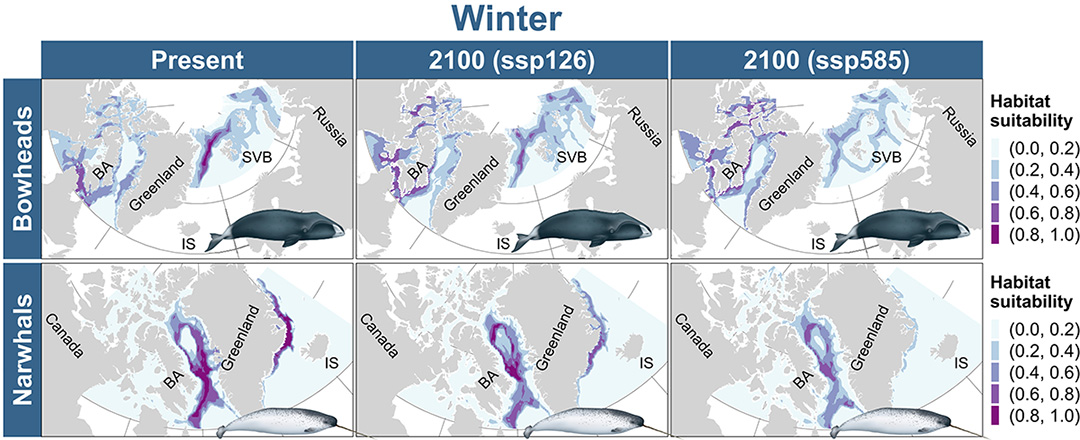
Bowhead whales, belugas, and narwhals are closely linked to cold seawater and sea ice in the Arctic. But the habitat of Arctic whales is shrinking as climate change causes sea ice to shrink and ocean temperatures to rise. A research team has now found that populations of the three whale species will shift further north by 2100. A quarter of their current distribution range in West Greenland in summer will have disappeared altogether by then. The study was recently published in the journal Science Advances.
In particular, water temperature at the sea surface is of importance to cetacean migrations and is a key indicator of whether an area meets the animals’ environmental needs. Climate forecasts predict that large parts of the Arctic Ocean will lose sea ice and sea temperatures will rise – more so east of Greenland and in the Barents Sea than off western Greenland.
The research team led by Philippine Chambault, scientist at the Greenland Institute of Natural Resources, therefore studied the migrations of a total of 227 bowhead whales(Balaena mysticetus), beluga whales (Delphinapterus leucas) and narwhals(Monodon monoceros) using satellite data over a 28-year period to predict their future distribution under two different climate change scenarios.

Their models, which considered sea surface temperature, salinity, and depth, found that by 2100 the ranges of all three cetacean species will shift northward, even using the most optimistic climate scenario, SSP126. For all three species, the researchers predict significant habitat losses of 25 percent, especially in summer. On average, the habitats of the three Arctic whales shift northward by 243 kilometers in summer and 121 kilometers in winter.

Red areas are projected losses by 2100, orange areas are projected to remain unchanged, and green areas are projected increases in habitat. Graphic: Chambault et al. 2022
Belugas in particular are vulnerable to environmental change because they are divided into smaller populations that exhibit high site fidelity. In particular, the more southerly populations around Baffin Island are threatened by increased warming and are not expected to migrate despite less favorable conditions.

Bowhead whales in the Canadian Arctic are expected to be able to live year-round in small refuges among the numerous islands. In East Greenland, they already live farther north compared to their historical range. Because they rely on zooplankton resources along the continental shelf, their ability to migrate even further north is limited.
The most sensitive of the three whale species to climate change is the narwhal. Its range is very limited because of its dependence on sea ice. It also has a specialized diet and a complex population structure. Population numbers of narwhals have already declined throughout their range. In East Greenland, the research team said, wintering habitats for narwhals are expected to disappear altogether.

The problem, Chambault said, is that at some point there will be no way to move further north, especially for the bowhead whales in East Greenland, which are already pretty far north. And although models predict that whales will migrate north, it’s not clear how quickly they will adapt.
In addition to habitat loss, climate change brings other adverse effects to bowhead whales, belugas, and narwhals. For example, researchers expect boreal species such as orcas, humpback whales, and harbor porpoises to also spread farther north, increasing competition for food. In addition, orcas would increasingly hunt Arctic whales and endanger them even more.
Climate change is also compounded by other anthropogenic stressors that negatively impact whale populations, such as resource exploitation, which contributes massively to noise pollution in the Arctic Ocean and is very likely to increase as sea ice diminishes.
Julia Hager, PolarJournal
More on the subject:





